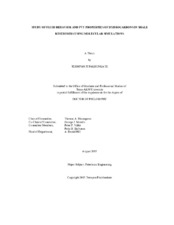Study of Fluid Behavior and PVT Properties of Hydrocarbons in Shale Reservoirs Using Molecular Simulations
| dc.contributor.advisor | Blasingame, Thomas A | |
| dc.contributor.advisor | Moridis, George J | |
| dc.creator | Pitakbunkate, Termpan | |
| dc.date.accessioned | 2015-10-29T19:53:20Z | |
| dc.date.available | 2017-08-01T05:37:41Z | |
| dc.date.created | 2015-08 | |
| dc.date.issued | 2015-08-07 | |
| dc.date.submitted | August 2015 | |
| dc.identifier.uri | https://hdl.handle.net/1969.1/155675 | |
| dc.description.abstract | Reservoir studies are crucial for field development plans. The level of the studies ranges from analogies to fully integrated production modeling. Numerical reservoir simulation is a tool to predict how fluid will flow in the reservoirs. It is developed based on the continuity equation, flow equation, and equation of state. The continuity equation is basically conservation of mass. Darcy’s law is a fundamental equation to describe fluid flow in a porous media (i.e. oil and gas reservoirs). Fluid properties in the reservoirs are calculated from the equation of state. This concept has been implemented to predict reservoir performance for over centuries and it works flawlessly for conventional reservoirs (i.e. sandstone and carbonate reservoirs). In the past decade, shale reservoirs became resources of future energy in the U.S. Shale reservoirs are unconventional reservoirs as their permeability is ultra-low and common pore sizes are in nanoscale level. Recent studies/research in the oil and gas industry mainly focus on explaining fluid flow behavior in the shale reservoirs. Some studies have been done in the oil and gas industry to describe how hydrocarbons are stored and flow through ultra-small pores in the shale reservoirs. Most of these studies were derived by borrowing and modifying techniques used for conventional reservoirs. Fluid properties in shale reservoirs are one of the keys to improve the accuracy of reservoir simulators. The common pore size distribution of the shale reservoirs is approximately 1-20 nm. In such confined spaces the interactions between the walls of the container (i.e. the shale and kerogen) and the contained fluids (i.e. the hydrocarbon fluids and water) may exert significant influence on the localized phase behavior. We believe this is due to the fact that the orientation and distribution of fluid molecules in the confined space are different from those of the bulk fluid; causing changes in the localized thermodynamic properties. This study provides a detailed account of the changes of PVT properties and phase behavior in a synthetic shale reservoir for pure hydrocarbons and their mixtures. Grand Canonical Monte Carlo (GCMC) simulations are performed to study the effect of confinement on the fluid properties and Molecular Dynamics (MD) simulations are performed to simulate movements of fluid molecules in a confined system and validate the conclusions obtained from the GCMC simulations. A graphite slab made of two layers is used to represent kerogen in the shale reservoirs. The separation between the two layers, representing a kerogen pore, is varied from 1 nm to 10 nm to observe the changes in the hydrocarbon fluid properties. We delivered phase diagrams and critical properties of pure hydrocarbons and phase diagrams of their mixtures. In addition, the deviations in the fluid densities in the confined space from those of the bulk fluids at reservoirs conditions were provided. | en |
| dc.format.mimetype | application/pdf | |
| dc.language.iso | en | |
| dc.subject | PVT properties | en |
| dc.subject | Molecular simulation | en |
| dc.subject | GCMC simulation | en |
| dc.subject | Monte Carlo simulation | en |
| dc.subject | Shale reservoirs | en |
| dc.subject | Confinement | en |
| dc.subject | MD simulation | en |
| dc.title | Study of Fluid Behavior and PVT Properties of Hydrocarbons in Shale Reservoirs Using Molecular Simulations | en |
| dc.type | Thesis | en |
| thesis.degree.department | Petroleum Engineering | en |
| thesis.degree.discipline | Petroleum Engineering | en |
| thesis.degree.grantor | Texas A & M University | en |
| thesis.degree.name | Doctor of Philosophy | en |
| thesis.degree.level | Doctoral | en |
| dc.contributor.committeeMember | Balbuena, Perla B | |
| dc.contributor.committeeMember | Valko, Peter P | |
| dc.type.material | text | en |
| dc.date.updated | 2015-10-29T19:53:20Z | |
| local.embargo.terms | 2017-08-01 | |
| local.etdauthor.orcid | 0000-0002-3635-0614 |
Files in this item
This item appears in the following Collection(s)
-
Electronic Theses, Dissertations, and Records of Study (2002– )
Texas A&M University Theses, Dissertations, and Records of Study (2002– )



